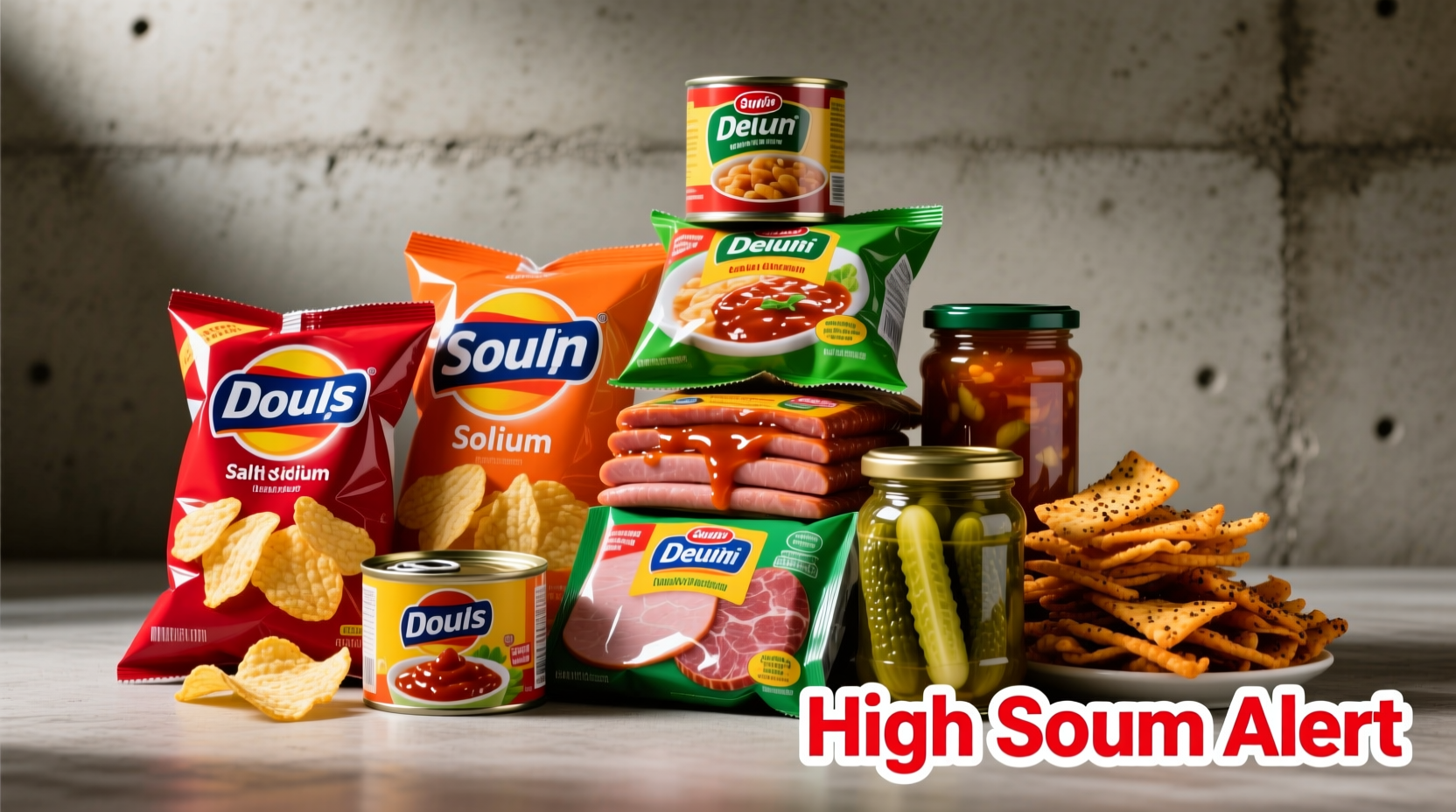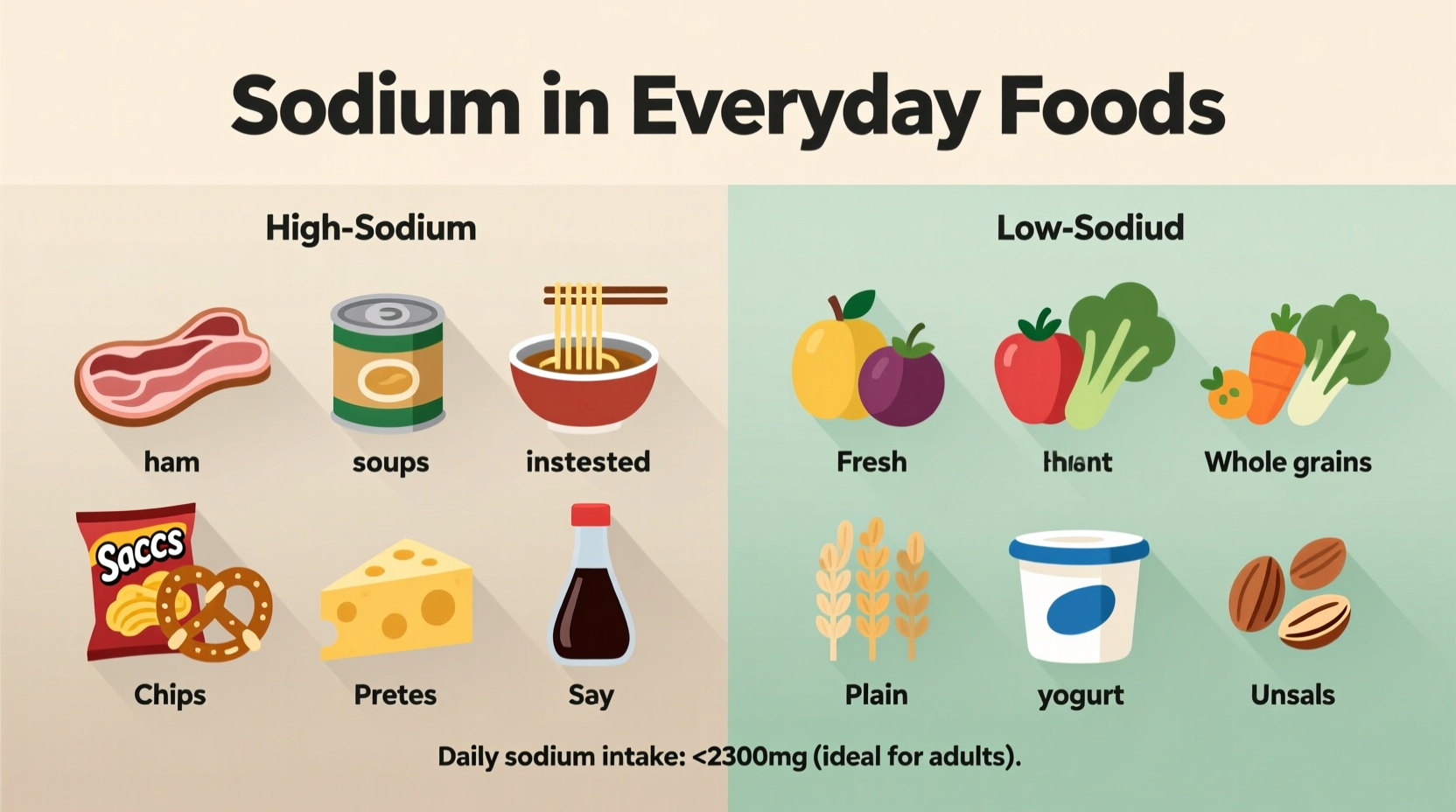The most significant sources of sodium in the average diet come from processed and prepared foods, not from the salt shaker. Processed meats, canned soups, restaurant meals, and packaged snacks typically contain the highest sodium levels. Naturally occurring sodium exists in smaller amounts in foods like milk, shellfish, and certain vegetables. Understanding where sodium hides in your diet is crucial for managing daily intake within the recommended limit of 2,300 mg.
When you search what foods contain sodium, you're likely trying to identify both obvious and hidden sources of sodium in your diet. This comprehensive guide reveals exactly where sodium lurks in everyday foods, backed by current nutritional data from authoritative health organizations. You'll learn to recognize high-sodium culprits, understand natural versus added sodium, and discover practical strategies for making informed dietary choices without sacrificing flavor.
Understanding Sodium Sources: Natural vs. Added
Sodium exists in two primary forms in our food supply: naturally occurring and added during processing or preparation. Natural sodium appears in modest amounts in certain foods like dairy products, seafood, and some vegetables. Added sodium, however, constitutes approximately 70% of the average American's daily intake according to the Centers for Disease Control and Prevention.
The distinction matters because added sodium often comes in forms you might not recognize—sodium benzoate, monosodium glutamate (MSG), sodium nitrate, and baking soda all contribute to your total sodium consumption. Learning to identify these hidden sources transforms how you approach food selection.
Top Categories of High-Sodium Foods
Processed Meats and Deli Products
These represent some of the most concentrated sodium sources in the modern diet. A single 2-ounce serving of processed deli meat can contain 500-1,000 mg of sodium—nearly half the daily recommended limit. The U.S. Food and Drug Administration identifies cured meats as major contributors to excessive sodium intake.
| Food Item | Portion Size | Sodium Content (mg) |
|---|---|---|
| Ham, sliced | 3 ounces | 1,000-1,500 |
| Bacon | 2 slices | 300-500 |
| Hot dogs | 1 frank | 500-700 |
| Pepperoni | 1 ounce | 500-700 |
Canned and Packaged Foods
Canned soups, pasta sauces, and frozen meals frequently contain surprisingly high sodium levels to enhance flavor and act as preservatives. A single serving of canned soup often delivers 700-1,000 mg of sodium. The USDA FoodData Central database reveals that many "low-sodium" labeled products still contain significant amounts compared to fresh alternatives.
Restaurant and Fast Foods
Meals prepared outside the home represent another major sodium source. A typical fast food cheeseburger contains approximately 1,000 mg of sodium, while many restaurant entrees exceed 2,000 mg per serving. The American Heart Association notes that restaurant meals often contain an entire day's recommended sodium in a single dish.
Condiments and Sauces
These seemingly small additions pack a sodium punch. Two tablespoons of soy sauce contains about 2,000 mg of sodium, while ketchup and salad dressings contribute significant amounts to your daily total. Many people overlook these liquid sodium sources when tracking their intake.
Naturally Occurring Sodium in Foods
Certain foods contain sodium naturally as part of their chemical composition. These generally provide much smaller amounts compared to processed foods:
- Milk and dairy products: 100-150 mg per cup
- Beef: approximately 50 mg per 3-ounce serving
- Shellfish: 100-500 mg depending on variety
- Celery and beets: naturally contain small amounts
These natural sources typically don't contribute significantly to excessive sodium intake. The real concern lies with added sodium in processed foods, which accounts for the majority of dietary sodium according to National Academies of Sciences, Engineering, and Medicine research.

How Sodium Recommendations Have Evolved
Sodium guidelines have shifted significantly as research has advanced. Understanding this timeline helps contextualize current recommendations:
- 1970s: First recognition of sodium's link to hypertension
- 1980s: Initial dietary guidelines suggesting moderation
- 2005: USDA recommends limiting to 2,300 mg daily
- 2010: American Heart Association tightens recommendation to 1,500 mg for optimal heart health
- 2020s: Focus shifts to processed food reformulation and consumer education
Context Matters: Sodium Needs Across Different Populations
While the general recommendation is 2,300 mg daily, individual needs vary significantly based on health status and lifestyle factors. People with hypertension, kidney disease, or heart conditions often require stricter limits of 1,500 mg. Athletes who sweat heavily may need slightly more sodium to replace losses, though this rarely exceeds standard recommendations.
The National Heart, Lung, and Blood Institute emphasizes that context determines appropriate sodium intake—what works for a sedentary office worker differs from an endurance athlete's needs. This nuanced understanding prevents oversimplified dietary advice that doesn't account for individual circumstances.
Practical Strategies for Managing Sodium Intake
Reading Nutrition Labels Effectively
When evaluating what foods contain sodium, focus on these label elements:
- Check the % Daily Value: 5% or less is low, 20% or more is high
- Compare similar products to find lower-sodium options
- Watch for serving size discrepancies
- Look for hidden sodium in ingredient lists
Smart Substitutions in Your Kitchen
Replace high-sodium ingredients with flavorful alternatives:
- Use fresh herbs instead of salt-based seasoning blends
- Try citrus juices and vinegars for brightness
- Choose no-salt-added canned goods
- Rinse canned beans to remove 40% of sodium
Dining Out Strategies
When eating at restaurants, request sauces and dressings on the side, ask for dishes to be prepared without added salt, and don't hesitate to inquire about lower-sodium options. Many establishments now accommodate these requests as awareness of sodium concerns grows.
Tracking Your Sodium Consumption
Most people significantly underestimate their daily sodium intake. Consider keeping a food diary for several days, noting both obvious and hidden sodium sources. Mobile nutrition tracking apps can help identify patterns and pinpoint where reductions might be most impactful without compromising enjoyment of your meals.











 浙公网安备
33010002000092号
浙公网安备
33010002000092号 浙B2-20120091-4
浙B2-20120091-4